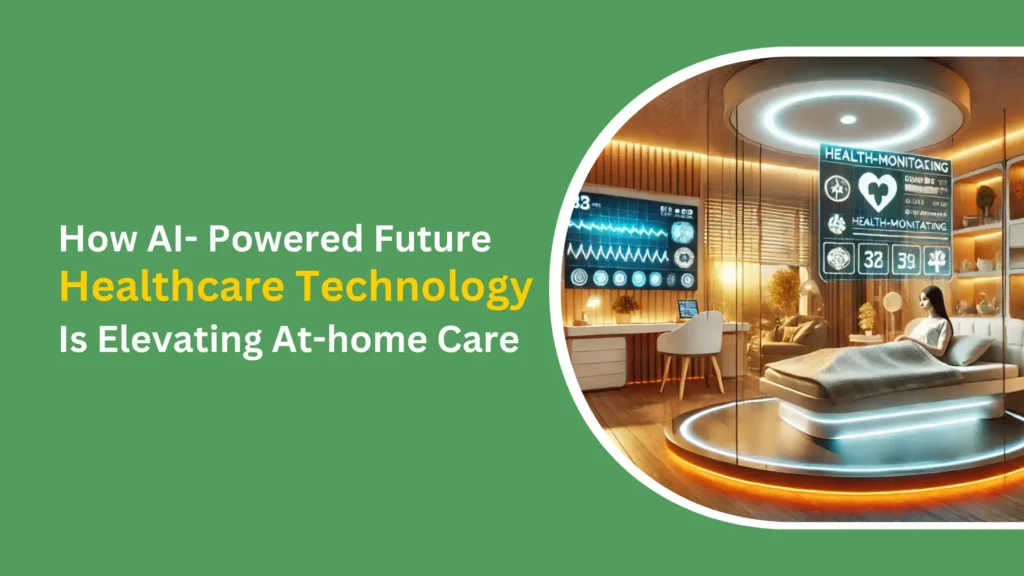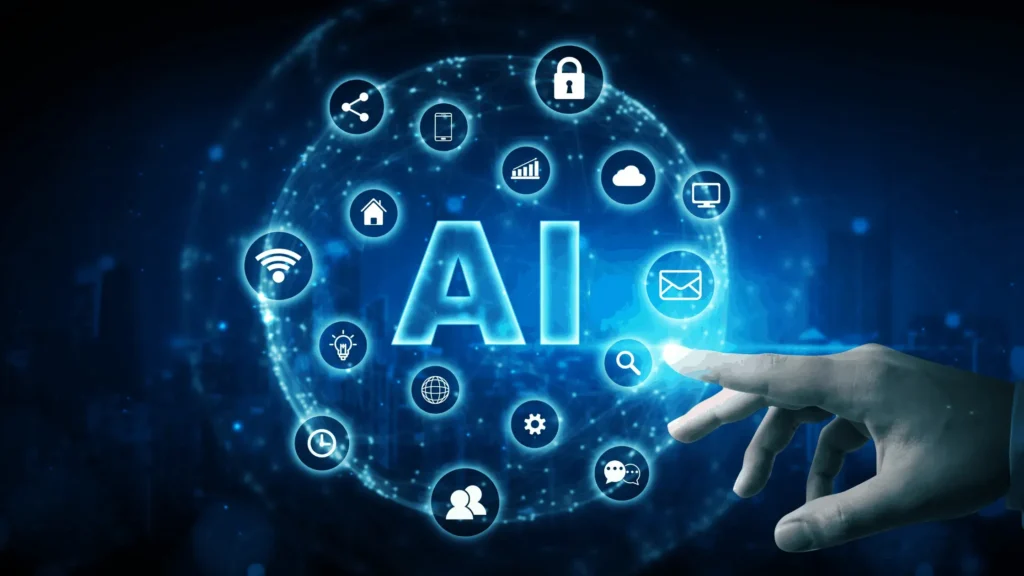The future of healthcare is rapidly shifting towards a more patient-centric, technology-driven model, with a strong emphasis on at-home care. This change in healthcare is influenced by several key factors. First, we have an aging population. Second, healthcare costs are rising. Finally, more people want better control and convenience in managing their healthcare. By leveraging AI-powered future healthcare technology, we can transform the traditional healthcare landscape, empowering individuals to proactively manage their health in the comfort of their homes.
The Evolving Landscape of At-Home Care
Transforming the Living Room: Advanced technologies, particularly AI-powered, rapidly transform the living room into a sophisticated healthcare hub.
Miniaturized Diagnostic Tools: AI-powered portable devices for blood tests, electrocardiograms (ECGs), and even ultrasounds are becoming increasingly accessible and affordable. These devices use AI to help you analyze health data, allowing you to perform basic health checks at home. This makes it easier to spot potential health issues early and get timely help.
Integration with Telehealth Platforms: Seamless integration with robust telehealth platforms powered by AI allows for real-time data sharing and remote consultations with healthcare providers. AI algorithms can analyze patient data from these devices. This helps doctors make more accurate diagnoses and create personalized treatment plans. It also improves remote monitoring of patients.
AI-Powered Healthcare: Revolutionizing Diagnostics and Patient Care
AI-Powered Diagnostics: AI algorithms are changing how we analyze medical images. They help doctors make quicker and more accurate diagnoses. AI-powered systems offer a game-changing solution for analyzing medical images such as X-rays and MRIs with impressive accuracy. These systems help radiologists find subtle abnormalities, improving the quality of diagnoses and speeding up the identification process. Embracing this technology can lead to quicker, more reliable patient care.
For example, AI algorithms can examine retinal images to find early signs of diabetic retinopathy. This condition can lead to vision loss. The algorithms are accurate and sensitive in their detection.
Predictive Analytics: AI can look at a lot of patient information, such as their medical history, lifestyle, and genetics, to predict health risks.
AI algorithms can help predict how likely a patient is to develop heart disease. They do this by looking at factors like the patient’s age, family history, smoking habits, and blood pressure readings. This proactive approach helps us implement personalized prevention strategies early on. These strategies may include changes to lifestyle, adjustments to medications, and more frequent screenings. This can help reduce potential health problems.
Personalized Treatment Plans: AI can look at patient data to create tailored treatment plans.
For example, AI algorithms can analyze a patient’s genetic information to predict their response to different medications, allowing for selecting the most effective and least likely to cause side effects.
This personalized approach enhances treatment effectiveness, patient safety, and overall healthcare outcomes.
Addressing the Needs of an Aging Population
Empowering Independent Living: AI-powered home care technologies help older adults stay independent and maintain their dignity. These tools support them in managing their health effectively. With this technology, seniors can live on their own for longer and rely less on institutional care.
Reducing the Burden on Caregivers: AI-powered solutions significantly benefit family caregivers. Remote monitoring devices, caregiver support networks, and AI-powered assistance tools can alleviate the burden of caregiving, allowing caregivers to manage their well-being better while providing the necessary support to their loved ones.
AI voice assistants can help caregivers schedule appointments, order medications, and check on their loved ones’ well-being from a distance.
Key Technologies Driving the At-Home Care Revolution
Telehealth Advancements:
High-Bandwidth Connectivity: High-bandwidth connectivity provides fast and reliable internet. This allows for high-quality video calls, smooth data transfers, and real-time remote monitoring.
AI-Powered Telehealth Platforms: AI can enhance telehealth platforms by enabling real-time translation, providing automated summaries of patient interactions, and even assisting with the initial triage of patient inquiries.
Remote Patient Monitoring (RPM):
Wearable Health Technology: AI-powered wearables go beyond basic fitness tracking to continuously monitor vital signs, activity levels, and sleep patterns and even detect early signs of disease.
Home-Based Medical Devices: AI algorithms can analyze data from home-based medical devices, such as blood pressure monitors and glucose meters, to identify potential health issues early on and alert healthcare providers.
Smart Home Healthcare:
IoT in Healthcare: Integrating Internet of Things (IoT) devices, such as smart refrigerators, voice assistants, and environmental sensors, can create a “smart home” environment that supports healthy living. AI can analyze data from these devices to provide personalized diet, exercise, and environmental adjustment recommendations.
Robotics in Home Care: AI-powered robots can help with daily tasks, provide social interaction, and check on patients’ health. They are important for supporting both patients and caregivers.
Building the Future of In-Home Healthcare
Addressing Challenges and Barriers:
Ensuring Equitable Access: Making sure everyone has access to technology and improving digital skills are important. This allows people from all backgrounds, no matter their income or where they live, to take advantage of these advances.
Data Privacy and Security: Protecting sensitive patient data is paramount.Strong data privacy and security measures are important for gaining trust in digital health solutions. They help ensure that patient information is used ethically and responsibly.
Collaboration and Innovation:
Multidisciplinary Collaboration: Working together is essential for healthcare providers, technology developers, researchers, patients, and policymakers. This collaboration helps drive innovation, solve problems, and ensure that technologies meet the changing needs of the healthcare system.
Focus on User Experience: Designing user-friendly and intuitive interfaces is crucial for ensuring patient engagement, maximizing the effectiveness of these technologies, and minimizing the risk of user error.
Conclusion
AI can change at-home care by making healthcare more personal, proactive, and easier to access for people everywhere. With AI, we can imagine a future where receiving care at home is not only convenient but also very effective. This will lead to better patient outcomes, improved quality of life, and a major shift in how healthcare is provided.
At Everite Solutions, we’re committed to shaping the future of healthcare through advanced technology. If you’re looking to implement AI-powered solutions to enhance patient care and streamline healthcare services, we’re here to help. Reach out to us today to discover how our innovative healthcare solutions can transform your services and bring your patient care to the next level.







